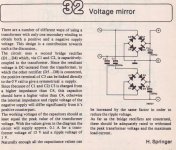I've searched this forum and the internet for this but haven't found the answer for this
I am building the classic Philips 40W hifi amplifier circuit which requires a 60V DC single rail supply
I have an old Technics amplifier chassis which has a 40-0-40 transformer
If I use this transformer with full wave rectification (2 diodes) and the center tap as ground, I can get 40 * 1.414 = 56V DC. This should work fine with my amplifier
My question is: Can I use the 40-0-40 transformer secondary to derive two independent 56V DC outputs using independent bridge rectifier and capacitor circuits? I want to do this so that I can have isolated power supply for each audio channel, which should improve channel seperation
If I use a rectification circuit between one 40V terminal and centre tap, and another between centre tap and the 2nd 40V terminal , can I get two independent 56V DC rails?
Will this work? Will there be a phase mismatch? Will the channel seperation be worth it? Or am I just better off using full wave rectification (two diodes) to get a single 56V rail?
I am building the classic Philips 40W hifi amplifier circuit which requires a 60V DC single rail supply
I have an old Technics amplifier chassis which has a 40-0-40 transformer
If I use this transformer with full wave rectification (2 diodes) and the center tap as ground, I can get 40 * 1.414 = 56V DC. This should work fine with my amplifier
My question is: Can I use the 40-0-40 transformer secondary to derive two independent 56V DC outputs using independent bridge rectifier and capacitor circuits? I want to do this so that I can have isolated power supply for each audio channel, which should improve channel seperation
If I use a rectification circuit between one 40V terminal and centre tap, and another between centre tap and the 2nd 40V terminal , can I get two independent 56V DC rails?
Will this work? Will there be a phase mismatch? Will the channel seperation be worth it? Or am I just better off using full wave rectification (two diodes) to get a single 56V rail?
You would need two isolated secondaries (4 wires) to make two isolated supplies.
One center tapped secondary (3 wires) won't do it.
One center tapped secondary (3 wires) won't do it.
Last edited:
But those two power supplies are not independent. They are galvanically connected.Here is a cute trick that might suit your needs...
It does the exact opposite to what OP wants, it creates a negative supply from a single winding, while he has two series connected windings and wants to get two same polarity supplies.
Which is impossible.
Besides, the "trick" works only for low consumption loads, such as a preamp, definitely NO power amp of any kind.
Which is impossible.
Besides, the "trick" works only for low consumption loads, such as a preamp, definitely NO power amp of any kind.
on an EI transformer, not toroid I have been able to remove a bit of the paper covering of the windings to find that the center tap is two wires twisted together. Separating those two wires now gives me two separate windings ie 0-30 and 0-30 whereas before they were 30-0-30. I was also able to parallel those 2 windings to give me a single 0-30 at double the current for a TPA3255 power supply
Thank you all for your replies. Multisync what you are saying could work. The only issue is that the Technics transformer is EI, but is so securely built that it might be tough to get at the windings. I'll give this a shot and see how it goes. Thanks 🙂
multysinc. This is good to known.
It is likely, this is true for toroids as well. Two wires wound together, with a connection hidden inside, you can get access as said.
It is likely, this is true for toroids as well. Two wires wound together, with a connection hidden inside, you can get access as said.
If you can live with 2 channels having the same ground, you add 2 more diodes and 1 more smoothing cap so you have 2 independent + voltages.
Two secondaries on the same transformer core will not provide two completely independent power supplies. Such DC power supplies can still communicate with each other through the primary which has resistance and parasitic capacitance linking to both coils. This means, if we call the two DC power supplies A and B, A will affect the primary and B will 'see' that effect.
- Home
- Amplifiers
- Power Supplies
- Two single rail supplies from a centre tap transformer
